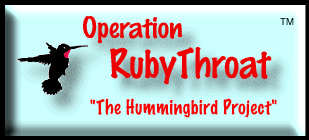 HOME: www.hiltonpond.org |
|||
|
RUFOUS HUMMINGBIRD |
|
In the Spring 2003 issue of Sandlapper magazine, an article about hummingbirds described our banding work being conducted through Hilton Pond Center for Piedmont Natural History and Operation RubyThroat: The Hummingbird Project. The issue hit subscriber mailboxes the week of 17 March--just in time for Nellie and Clayton Land to read it and alert us about two (or three) hummers that had been spending most of the winter at their house in Seneca SC (Oconee County). We weren't surprised at the Land family's good fortune, since we'd already banded several vagrant hummers in the past three winters in that extreme northwestern corner of the state, which--along with the coastal region and our home county of York--seems to get the bulk of South Carolina's winter hummingbirds. Since winter hummers typically leave the Carolinas beginning in mid-February, we were eager to get to Seneca to trap these newly reported birds lest they depart unbanded and unverified. To be honest, we were not too optimistic that the vagrant hummingbirds would hang around the Lands' feeder much longer, especially with temperatures soaring into the mid-70s and the emergence of flower buds and protein-rich spring insects. Regardless, we arranged to travel to the Land residence on 24 March. We arrived at 6:20 a.m. and heard--as often seems the case--that at least one hummingbird had made a feeder visit "just before" we arrived. This was disappointing because in our experience it's far easier to trap winter hummers early in the morning, preferably on their first feeding foray after a night of fasting. Hurriedly, we set up our portable hummingbird trap, placed a feeder in it, and by 6:30 a.m. had joined the Lands in the comfort of their den, which overlooks a nicely landscaped yard that invites many species of birds.
The Lands suspected that at least one of their winter hummers--a brownish one--was a male Rufous Hummingbird. Sure enough, within 15 minutes or so a partly rust-colored bird inspected the outside of the trap and lingered long enough to show that it was indeed a second-year male Selasphorus hummer--either a Rufous or an Allen's; this bird, Mrs. Land said, had been around since November 2002. A few minutes later a second hummingbird zipped in, hovered around the trap, and flashed a rusty-based tail, indicating it was likely a female Selasphorus and the one that showed up at the Land's feeder the second week in January 2003. For the next four hours we sat with the Lands, discussing bird banding, bird feeding, bird watching, bird behavior, general philosophy, gardening, the weather, Mr. Land's upcoming 80th birthday, and a variety of other topics, all the while watching as both hummingbirds made several trips to the trap before dashing away--usually off to the right of the picture window. Oh, if only we had known about these vagrant birds a month earlier when the weather was cold and they were making feeder visits every few minutes. To make the long, sad story a bit shorter, after failing to catch either bird by 10:30 a.m. we packed up the old hummingbird trap, thanked the Lands for their hospitality, and headed back toward Hilton Pond with a great deal of humility. But we also vowed we would return later in the week to try once again--so long as the hummingbirds were still hanging around. 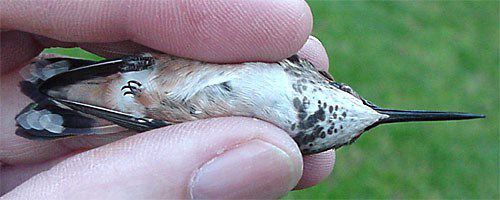 After a few more days of balmy weather, we checked the long-range forecast on 27 March, learning to our surprise that a cold front was on the way and that temperatures at or just below the freezing mark were predicted for the night of 30 March. Realizing this cold spell might be the last one of the year, we decided to make the 120-mile trip to Seneca and to be there very early on the morning of 31 March--well before the waking hour for chilly, hungry hummingbirds. This time we arrived at the Land residence by 5:30 a.m., and this time we had another trick up our sleeve. As usual, we took down the Lands' hummingbird feeder and placed it inside our portable trap. But right afterwards--in the pre-dawn darkness--we also erected an 18-foot-long, seven-foot-tall mist net to the right of the picture window, the very direction we'd seen the hummingbirds fly to and from the previous week. By 6 a.m. the net was unfurled and the skies were just beginning to lighten, so we made a final check of the trap to be sure it was properly set--only to have a hummingbird fly up and almost land on our shoulder! "Drat," we thought, "we've just blown our best chance at catching this bird." Dejectedly, we retired to a hiding spot from which we could watch the trap and, to be honest, got a bit fidgety when the hummingbird we'd just seen didn't return immediately to the trap-enclosed feeder. Seconds ticked by, then minutes, and at 6:10 a.m. we decided to risk blowing our cover by walking out to investigate the mist net. Lo, and behold, right smack in the middle of it was a hummingbird--we had managed to catch one after all! 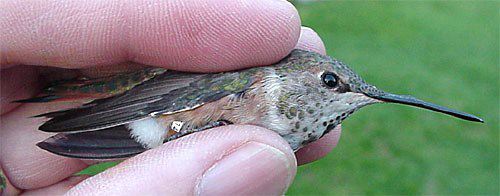 The hummer was only loosely tangled, so we quickly extricated her from the soft mesh and took her into the Lands' sun porch, where our just-awakened hosts were both pleased and surprised by news that one of their winter hummingbirds was already in hand. Since we'd caught the bird so early, we stuck her bill in a feeder port and watched as she partook readily of a sumptuous breakfast of sugar water. After examining the plumage and making the usual measurements (below), we determined that our newly captured bird was indeed a healthy female Rufous Hummingbird, S. rufus, with a nice cluster of metallic red-orange feathers on her throat and substantial rust in her tail. She also had a small healed-over bump near the base of her upper bill, perhaps caused by an old injury or infection. Based on our own work and reports by some other banders, these bumps seem to be unusually common on winter vagrant hummers but occur much less frequently in our summer resident Ruby-throated Hummingbirds. Age/Sex--After hatch year female Weight--3.47g Wing Chord--42.2mm Tail Length-26.5mm Tail Fork--7mm Culmen (upper bill)--18mm Bill Corrugations--None visible (bump on bill obscured visibility) Gorget--17+ orange-red metallic feathers Having banded, measured, and photographed the Lands' female Rufous, we released her and went back to the sun porch to await the visit of the suspected male. We anticipated it would be an exercise in futility, because the Lands had not seen him at their feeder since 26 March. Over the next hour, the banded female Rufous made one return visit to the trap; meanwhile, the mist net managed to snare several non-hummingbirds, including Northern Cardinals, Eastern Towhees, White-throated Sparrows, Mourning Doves, Carolina Wrens, and Tufted Titmice--all of which we released unbanded. By 7:30 a.m., the temperature was already rising and the sun was shining directly on the net--both factors that made it unlikely we would catch any more hummingbirds that day. So, not wishing to be too greedy after banding one Rufous Hummingbird, we took down the mist net and the trap, re-hung the hummer feeders, and bid fond farewell to Nellie and Clayton Land with thanks and full expectation we would would visit much earlier next year to catch and band their anticipated new crop of winter vagrant hummingbirds. POSTSCRIPT #1: After departing Seneca on 31 March, we made a side trip to the home of Norma Ballard in Piedmont SC and observed our first Ruby-throated Hummingbird of the season, an adult male in pristine plumage. So long winter vagrants; bring on the ruby-throats! POSTSCRIPT #2: On 26 December 2003 we returned to Seneca SC and recaptured #Y14807.
If you're interested in sharing your hummingbird observations and learning from other enthusiasts, you may wish to subscribe to Hummingbird Hobnob, our Yahoo!-based discussion group. Also be sure to visit our award-winning Web site for Operation RubyThroat: The Hummingbird Project; on it you'll find almost anything you want to know about hummingbirds, including more information about Hummingbird Banding.
For much more information about hummingbirds, visit Operation RubyThroat: The Hummingbird Project |
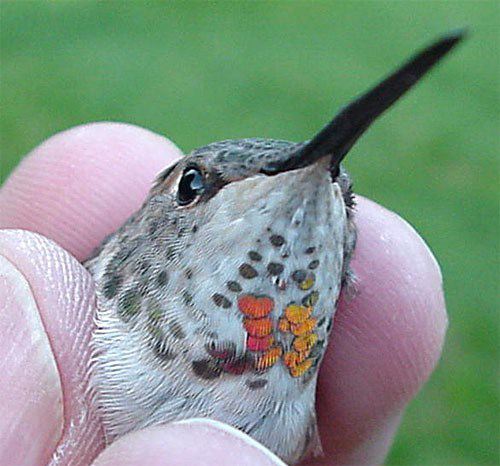

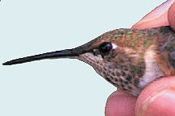
 Students at GLOBE-certified schools may submit winter hummingbird observations as part of Operation RubyThroat and GLOBE. Students can also correlate hummingbird observations with data on abiotic factors, including atmosphere, climate, hydrology, soils, land cover, and phenology. See the
Students at GLOBE-certified schools may submit winter hummingbird observations as part of Operation RubyThroat and GLOBE. Students can also correlate hummingbird observations with data on abiotic factors, including atmosphere, climate, hydrology, soils, land cover, and phenology. See the 